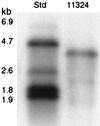Expression and functional properties of the Streptococcus intermedius surface protein antigen I/II
- PMID: 11402009
- PMCID: PMC98542
- DOI: 10.1128/IAI.69.7.4647-4653.2001
Expression and functional properties of the Streptococcus intermedius surface protein antigen I/II
Abstract
Streptococcus intermedius is associated with deep-seated purulent infections. In this study, we investigated expression and functional activities of antigen I/II in S. intermedius. The S. intermedius antigen I/II appeared to be cell surface associated, with a molecular mass of approximately 160 kDa. Northern blotting indicated that the S. intermedius NCTC 11324 antigen I/II gene was transcribed as a monocistronic message. Maximum expression was seen during the early exponential phase. Insertional inactivation of the antigen I/II gene resulted in reduced hydrophobicity during early exponential phase, whereas no effect was detected during mid- and late exponential phases. Binding to human fibronectin and laminin was reduced in the isogenic mutant, whereas binding to human collagen types I and IV and to rat collagen type I was not significant for either the wild type or the mutant. Compared to the wild type, the capacity of the isogenic mutant to induce interleukin 8 (IL-8) release by THP-1 monocytic cells was significantly reduced. The results indicate that the S. intermedius antigen I/II is involved in adhesion to human receptors and in IL-8 induction.
Figures








Similar articles
-
Functional variation of the antigen I/II surface protein in Streptococcus mutans and Streptococcus intermedius.Infect Immun. 2002 Jan;70(1):249-56. doi: 10.1128/IAI.70.1.249-256.2002. Infect Immun. 2002. PMID: 11748190 Free PMC article.
-
Involvement of antigen I/II surface proteins in Streptococcus mutans and Streptococcus intermedius biofilm formation.Oral Microbiol Immunol. 2005 Dec;20(6):366-71. doi: 10.1111/j.1399-302X.2005.00244.x. Oral Microbiol Immunol. 2005. PMID: 16238597
-
Adherence and internalization of Streptococcus gordonii by epithelial cells involves beta1 integrin recognition by SspA and SspB (antigen I/II family) polypeptides.Cell Microbiol. 2007 Jan;9(1):65-83. doi: 10.1111/j.1462-5822.2006.00768.x. Epub 2006 Jul 31. Cell Microbiol. 2007. PMID: 16879454
-
Differential binding specificities of oral streptococcal antigen I/II family adhesins for human or bacterial ligands.Mol Microbiol. 2005 Mar;55(5):1591-605. doi: 10.1111/j.1365-2958.2005.04495.x. Mol Microbiol. 2005. PMID: 15720563
-
Histone-like DNA binding protein of Streptococcus intermedius induces the expression of pro-inflammatory cytokines in human monocytes via activation of ERK1/2 and JNK pathways.Cell Microbiol. 2008 Jan;10(1):262-76. doi: 10.1111/j.1462-5822.2007.01040.x. Epub 2007 Sep 20. Cell Microbiol. 2008. PMID: 17883418
Cited by
-
Intermolecular forces and enthalpies in the adhesion of Streptococcus mutans and an antigen I/II-deficient mutant to laminin films.J Bacteriol. 2007 Apr;189(8):2988-95. doi: 10.1128/JB.01731-06. Epub 2007 Feb 2. J Bacteriol. 2007. PMID: 17277062 Free PMC article.
-
The Multifaceted Nature of Streptococcal Antigen I/II Proteins in Colonization and Disease Pathogenesis.Front Microbiol. 2020 Nov 25;11:602305. doi: 10.3389/fmicb.2020.602305. eCollection 2020. Front Microbiol. 2020. PMID: 33329493 Free PMC article. Review.
-
A collagen-binding adhesin, Acb, and ten other putative MSCRAMM and pilus family proteins of Streptococcus gallolyticus subsp. gallolyticus (Streptococcus bovis Group, biotype I).J Bacteriol. 2009 Nov;191(21):6643-53. doi: 10.1128/JB.00909-09. Epub 2009 Aug 28. J Bacteriol. 2009. PMID: 19717590 Free PMC article.
-
The role of Streptococcus intermedius in brain abscess.Eur J Clin Microbiol Infect Dis. 2013 Apr;32(4):477-83. doi: 10.1007/s10096-012-1782-8. Epub 2012 Nov 28. Eur J Clin Microbiol Infect Dis. 2013. PMID: 23187823 Review.
-
Pangenome analysis and virulence profiling of Streptococcus intermedius.BMC Genomics. 2021 Jul 9;22(1):522. doi: 10.1186/s12864-021-07829-2. BMC Genomics. 2021. PMID: 34238216 Free PMC article.
References
-
- Al-Okla S, Chatenay-Rivauday C, Klein J P, Wachsmann D. Involvement of α5β1 integrins in interleukin 8 production induced by oral viridans streptococcal protein I/IIf in cultured endothelial cells. Cell Microbiol. 1999;1:157–168. - PubMed
-
- Chatenay-Rivauday C, Yamodo I, Sciotti M A, Ogier J A, Klein J P. The A and the extended V N-terminal regions of streptococcal protein I/IIf mediate the production of tumour necrosis factor alpha in the monocyte cell line THP-1. Mol Microbiol. 1998;29:39–48. - PubMed
MeSH terms
Substances
LinkOut - more resources
Full Text Sources
Molecular Biology Databases

